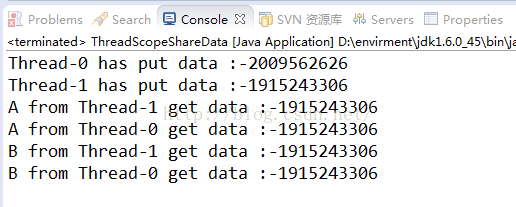线程范围内共享变量要实现的效果为:
多个对象间共享同一线程内的变量
未实现线程共享变量的demo:
package cn.itcast.heima2;
import java.util.HashMap;
import java.util.Map;
import java.util.Random;
public class ThreadScopeShareData {
private static int data = 0;
// private static Map<Thread, Integer> threadData = new HashMap<Thread, Integer>();
public static void main(String[] args) {
//共启动2个线程
for(int i=0;i<2;i++){
//启动一个线程
new Thread(new Runnable(){
@Override
public void run() {
data = new Random().nextInt();
System.out.println(Thread.currentThread().getName()
+ " has put data :" + data);
//以当前线程为key值放入到map中,当取值时根据各自的线程取各自的数据
// threadData.put(Thread.currentThread(), data);
new A().get();
new B().get();
}
}).start();
}
}
static class A{
public void get(){
// int data = threadData.get(Thread.currentThread());
System.out.println("A from " + Thread.currentThread().getName()
+ " get data :" + data);
}
}
static class B{
public void get(){
// int data = threadData.get(Thread.currentThread());
System.out.println("B from " + Thread.currentThread().getName()
+ " get data :" + data);
}
}
}运行结果:

通过打印出的结果可以看出,当Thread-0获取了一个随机数,修改了data的值,正在睡眠的时候,Thread-1又获取了一个随机数,同样修改了data的值,然后Thread-1调用了静态内部类A和B的get方法,实际上此时的data已经是Thread-1拿到的随机数了。
当然,我们可以通过增加synchronized加锁来控制线程的运行。让Thread-0运行完方法之前,Thread-1不能修改data的值。
此外,还可以使用另外几种方法来获取线程运行时变量赋予的真正值。
线程范围内共享变量实现方式:
Map实现方式:
package cn.itcast.heima2;
import java.util.HashMap;
import java.util.Map;
import java.util.Random;
public class ThreadScopeShareData {
private static Map<Thread, Integer> threadData = new HashMap<Thread, Integer>();
public static void main(String[] args) {
//共启动2个线程
for(int i=0;i<2;i++){
//启动一个线程
new Thread(new Runnable(){
@Override
public void run() {
int data = new Random().nextInt();
System.out.println(Thread.currentThread().getName()
+ " has put data :" + data);
//以当前线程为key值放入到map中,当取值时根据各自的线程取各自的数据
threadData.put(Thread.currentThread(), data);
new A().get();
new B().get();
}
}).start();
}
}
static class A{
public void get(){
int data = threadData.get(Thread.currentThread());
System.out.println("A from " + Thread.currentThread().getName()
+ " get data :" + data);
}
}
static class B{
public void get(){
int data = threadData.get(Thread.currentThread());
System.out.println("B from " + Thread.currentThread().getName()
+ " get data :" + data);
}
}
}运行结果:

ThreadLocal方式:
package cn.itcast.heima2;
import java.util.Random;
public class ThreadLocalTest {
private static ThreadLocal<Integer> x = new ThreadLocal<Integer>();
public static void main(String[] args) {
for(int i=0;i<2;i++){
new Thread(new Runnable(){
@Override
public void run() {
int data = new Random().nextInt();
System.out.println(Thread.currentThread().getName()
+ " has put data :" + data);
x.set(data);
new A().get();
new B().get();
}
}).start();
}
}
static class A{
public void get(){
int data = x.get();
System.out.println("A from " + Thread.currentThread().getName()
+ " get data :" + data);
}
}
static class B{
public void get(){
int data = x.get();
System.out.println("B from " + Thread.currentThread().getName()
+ " get data :" + data);
}
}
}
存在的问题:一个ThreadLocal代表一个变量,故其中只能放一个数据,如果你有两个变量要线程范围内共享,则要定义两个ThreadLocal。如下为解决方案:
扩展方式-单例方式处理对象:
package cn.itcast.heima2;
import java.util.Random;
public class ThreadLocalTest {
// 方式一
// private static ThreadLocal<Integer> x = new ThreadLocal<Integer>();
private static ThreadLocal<MyThreadScopeData> myThreadScopeData = new ThreadLocal<MyThreadScopeData>();
public static void main(String[] args) {
for(int i=0;i<2;i++){
new Thread(new Runnable(){
@Override
public void run() {
int data = new Random().nextInt();
System.out.println(Thread.currentThread().getName()
+ " has put data :" + data);
// 方式一 ThreadLocal
// x.set(data);
// 方式二 new对象方式,将多个属性放到对象中
// MyThreadScopeData myData = new MyThreadScopeData();
// myData.setName("name" + data);
// myData.setAge(data);
// myThreadScopeData.set(myData);
// 方式三 使用单例模式
MyThreadScopeData.getThreadInstance().setName("name" + data);
MyThreadScopeData.getThreadInstance().setAge(data);
new A().get();
new B().get();
}
}).start();
}
}
static class A{
public void get(){
// 方式一 ThreadLocal
// int data = x.get();
// System.out.println("A from " + Thread.currentThread().getName()
// + " get data :" + data);
// 方式二 new对象方式,将多个属性放到对象中
// MyThreadScopeData myData = myThreadScopeData.get();;
// System.out.println("A from " + Thread.currentThread().getName()
// + " getMyData: " + myData.getName() + "," +
// myData.getAge());
// 方式三 使用单例模式
MyThreadScopeData myData = MyThreadScopeData.getThreadInstance();
System.out.println("A from " + Thread.currentThread().getName()
+ " getMyData: " + myData.getName() + "," +
myData.getAge());
}
}
static class B{
public void get(){
// int data = x.get();
// System.out.println("B from " + Thread.currentThread().getName()
// + " get data :" + data);
// MyThreadScopeData myData = myThreadScopeData.get();;
// System.out.println("B from " + Thread.currentThread().getName()
// + " getMyData: " + myData.getName() + "," +
// myData.getAge());
MyThreadScopeData myData = MyThreadScopeData.getThreadInstance();
System.out.println("B from " + Thread.currentThread().getName()
+ " getMyData: " + myData.getName() + "," +
myData.getAge());
}
}
}
class MyThreadScopeData{
private MyThreadScopeData(){}
private static MyThreadScopeData instance = null;//new MyThreadScopeData();
private static ThreadLocal<MyThreadScopeData> map = new ThreadLocal<MyThreadScopeData>();
public static /*synchronized*/ MyThreadScopeData getThreadInstance(){
MyThreadScopeData instance = map.get();
if(instance == null){
instance = new MyThreadScopeData();
map.set(instance);
}
return instance;
}
private String name;
private int age;
public String getName() {
return name;
}
public void setName(String name) {
this.name = name;
}
public int getAge() {
return age;
}
public void setAge(int age) {
this.age = age;
}
}
总结:
synchronized和使用ThreadLocal均可以解决以上的问题,只是这是两种不同的方式,synchronized是依赖锁的机制一个执行完后另一个再执行。ThreadLocal会为每一个线程维护一个和该线程绑定的变量的副本,从而隔离了多个线程的数据,每一个线程都拥有自己的变量副本,从而也就没有必要对该变量进行同步了。
概括起来说,对于多线程资源共享的问题,同步机制采用了“以时间换空间”的方式,而ThreadLocal采用了“以空间换时间”的方式。前者仅提供一份变量,让不同的线程排队访问,而后者为每一个线程都提供了一份变量,因此可以同时访问而互不影响。
当然ThreadLocal并不能替代同步机制,两者面向的问题领域不同。同步机制是为了同步多个线程对相同资源的并发访问,是为了多个线程之间进行通信的有效方式;而ThreadLocal是隔离多个线程的数据共享,从根本上就不在多个线程之间共享资源(变量),这样当然不需要对多个线程进行同步了。
ThreadLocal的应用:
在业务逻辑层需要调用多个Dao层的方法,我们要保证事务(jdbc事务)就要确保他们使用的是同一个数据库连接.那么如何确保使用同一个数据库连接呢?





























 被折叠的 条评论
为什么被折叠?
被折叠的 条评论
为什么被折叠?








